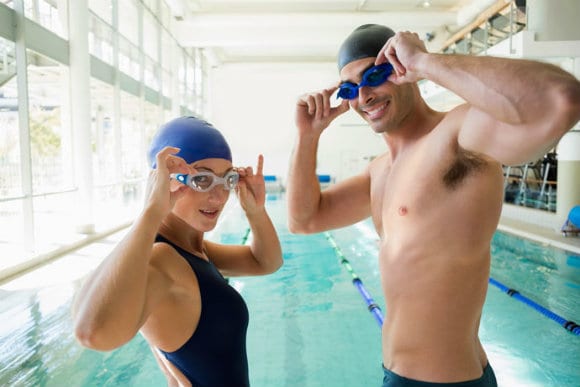By healthiergang writer , swimming instructor and student in sports science.
Learn to Swim
With the summer heat, there is nothing more beautiful than diving into a nice swimming pool for a refreshing swim, before a day of work or after.
In both cases, swimming helps us relax, to detach your mind from everyday problems. But what if we can't swim? How to get close to the pool?
I thought I'd propose to you 5 basic tips, very simple, to put into practice if you are not accustomed to the aquatic world. These are the first small steps that will prepare you to face the first workouts and to feel satisfied with yourself.

# 1 The horizontal position
It may sound trite, but it is one of the first obstacles to face. As human beings moving on two limbs, our position on the earth is vertical.
When we are in the water, everything changes. The environment is made up of a totally different element for which our body is not specifically equipped. In the water we move both vertically and horizontally: we soon discover moving horizontally is more effective and economical. We must therefore familiarize yourself with this positionsia supini che proni.
How to do? Let's try to float: let's let ourselves go, lift our feet from the bottom and let ourselves be rocked. Let us lie down both on our backs and on our backs, let us slide on the water. Let's focus on the sensations we feel. The result must be a positive physical and mental experience.
# 2 Relax
It is the natural consequence of the first advice.
If we are not relaxed but stiff, our body will drop to the bottom of the pool like a stone (do not worry, you can safely stand up if this happens). If instead we relax, we have confidence in ourselves, our body will be lighter and more fluid.
We try to first of all relax the neck and shouldersle, then the arms, take long, deep breaths, and finally let go of the legs. It is important to be aware of how rigid or fearful it can hinder us in our approach to swimming.
# 3 Don't depend too much on the material
In the pool we often find many objects colored floats, tablets, pull buoys, tubes, etc. that peek out of large baskets and seem to call us inviting.
Dear friends, if you are a beginner in the practice of swimming it is okay to "give in" once or twice, but your path should not depend on the use of flotation tools.
In my courses (both swimming and water fitness) I tend to rarely use the "extra" material, both with adults and with children, as I believe it is important to focus on your body and its reactions to the stimuli we give it.
It is important to "program" the new motor patterns using only our body. Only later, when these are well established, will we be able to use the material to vary our training sessions. So all you have to do is experiment, float, move your legs and arms in the way that is most natural to you ...
#4 Bolle
Bubbles! Just as the movement in the water is to be "reprogrammed", so too the breathing needs attention. Let us remember that in our terrestrial environment we breathe almost without realizing it: we inhale oxygen and exhale carbon dioxide.
When we are in the water, what happens? The first few times you can even be scared distressed by the idea of drowning. But let's remember to be relaxed and don't panic.
The only way to do not ingest water when diving even with the head is to make bubbles! Blow hard with your nose and mouth. As you try it will become more and more familiar and you will no longer even realize that you automatically blow air out of your nose and mouth when you dive. And we absolutely avoid "pinching" our nose with our fingers!
Our goal must be to learn how to manage our relationship with water at 360 °, avoiding "shortcuts".
# 5 Don't worry
Water is our friend. Our body is made up of 60% water. Before we are born we float in a bag full of water. Infants within the first months of life know how to move in water as if they were still in the placenta. Why be afraid?
We make sure that our experience in the pool is positive: every time we try to swim or always move a little longer, let's try to keep the head under water a little bit more, let's look at what the world is like below the surface (if you are at the sea).
Let's do it realistic and minimal goals and commit ourselves to achieving themthe. We stay in the lower part of the pool if the one where the water is deeper still frightens us, and let's venture only when we feel safer.
Ask the lifeguard on duty or an instructor for advice, will be able to help you if you have any doubts and will follow you if you feel insecure: in any case, you are not alone! Conclusion The advice in this article is very simple and basic. Sometimes it is assumed that anyone who enters the pool knows how to swim or has already had experience with water.
Very often, however, it happens that even those who attend fitness courses (bike, treadmill or aquagym) do not know how to swim or do not feel comfortable in the water. Before improvising as swimmers, without ever having had experience or having attended swimming lessons, let's try this "soft" approach based on experiencing one's body in a different environment, in which different physical rules apply. From there, we will be ready to start our journey as swimmers - be it for a season, for a year or for a lifetime - with great personal satisfaction and psychophysical well-being.

























